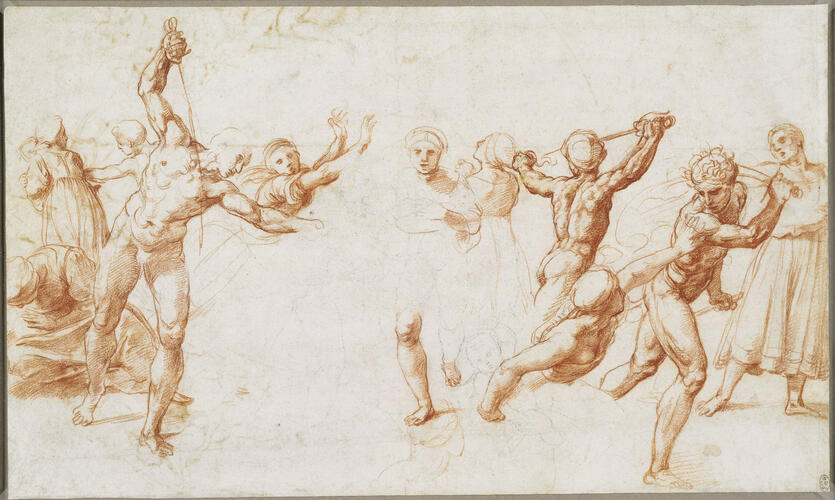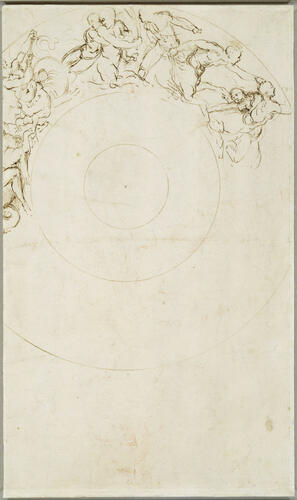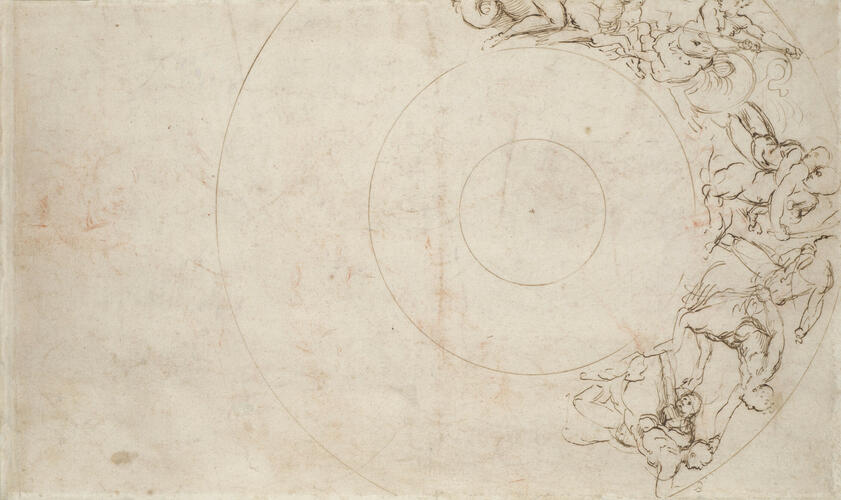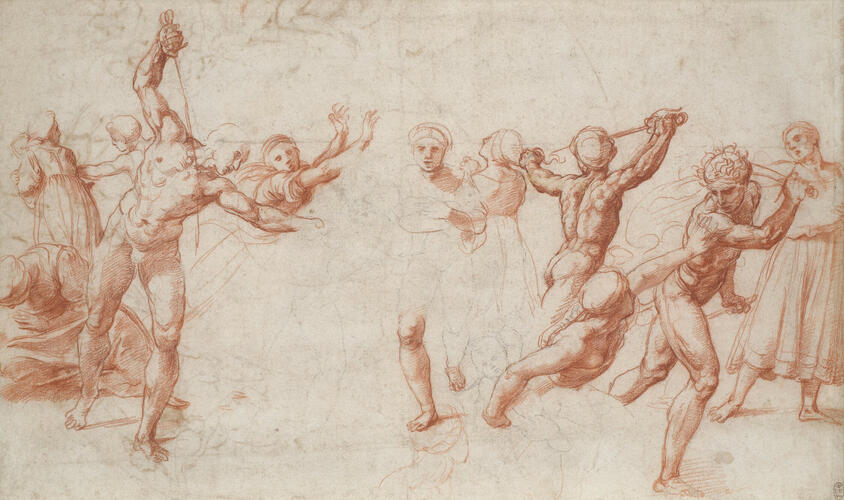-
1 of 253523 objects
Recto: The Massacre of the Innocents. Verso: A design for a salver c.1510
Recto: Red chalk over charcoal pounce-marks, stylus and black chalk underdrawing. Verso: pen and ink. Watermark of a mermaid in a circle. | 24.6 x 41.3 cm (sheet of paper) | RCIN 912737

Raphael (1483-1520)
The Massacre of the Innocents c.1510

Raphael (1483-1520)
The Massacre of the Innocents c.1510

Raphael (1483-1520)
The Massacre of the Innocents c.1510




-
The drawing depicts the massacre of male children ordered by Herod the Great, king of Judea, immediately after the birth of Christ, as described in the Gospel of St Matthew (2:16–18). It is a study for an engraving by Marcantonio Raimondi, known in two principal versions (Bartsch 18, 20; there are also several copies – see the material in Prince Albert’s Raphael Collection, RCIN 850413-30). It seems that both plates were engraved by Marcantonio, the first under contract from Raphael and his agent, Il Baviera, the second (possibly surreptitiously) on Marcantonio's own initiative, to gain from the popularity of a print that he had engraved but that was then out of his control.
The composition sprang from a rejected idea for Raphael’s Judgment of Solomon, a small fresco that also depicts a soldier threatening a baby with a sword, in the vault of the Stanza della Segnatura of the Vatican palace (for an account of the Segnatura, see RCIN 912734). A study in Vienna for that fresco has the mother as painted in the Segnatura, together with the swordsman essentially in the pose of the principal soldier on the left here; a companion sheet also in Vienna repeats that swordsman, but with the mother rushing her child away from him as in the Massacre.
It is therefore probable that the composition of the Massacre is contemporary with the ceiling of the Segnatura, though it must have been intended from the outset for an engraving, for it is too even in its figuration and narrative emphasis to function well as a painting – the multiple, equally-weighted centres of attention are more suited to an object to be held in the hands and perused at leisure. The Massacre has a good claim to be the first print produced as a collaboration between Raphael and Marcantonio, a partnership that was to be so fruitful over the next decade.
The drawing corresponds closely, so far as it goes, with the composition as engraved. An earlier pen study in the British Museum (1860,0414.446) likewise corresponds in scale and motif, but there the figures are nude, and the group of the soldier pulling back a woman by the hair is reprised further to the right, over a red chalk underdrawing and with the figure group rotated through ninety degrees. The figures drawn in pen only on the British Museum sheet were then pricked and transferred by pouncing to the present sheet: several figures are seen here only as a pattern of dots, connected by direct drawing with a stylus that has dragged out the charcoal powder along the contours. The figures not studied in the British Museum sheet were underdrawn here in stylus and a little black chalk. The composition was then worked up in red chalk, not as a mere repetition of the British Museum sheet, for the figures are adjusted throughout to tip them further into unstable equilibrium, enhancing the sense of stylised and bloodless violence.
The final stage of Raphael's work known to us is probably a highly finished pen drawing in Budapest in which all the figures are as found in the engraving, excepting the two dead infants lying in the foreground. The draftsmanship of that sheet seems lively and varied, but it may be a good partial copy after Raphael’s model for the engraver. It cannot be itself the final model, for only the parapet is drawn in, and it is inconceivable that Raphael would leave Marcantonio to devise the background architecture (with the Roman bridge, the Ponte Quattro Capi), so important for the rhythm of the whole composition.
On the verso of the sheet is a sketch of battling marine creatures, within three circles drawn with compasses, and surely a study for metalwork. The motif of a sea-centaur pulling back by the hair another who is abducting a nymph is derived directly from the British Museum Massacre mentioned above.
On 10 November 1510 Cesare Rossetti acknowledged an advance for two bronze salvers for Agostino Chigi, each four palmi (about 920mm) in diameter, to be decorated with flowers in relief after designs by Raphael. Although the decorative motif of flowers does not agree with that studied here, this document does demonstrate that Raphael was providing designs for metalwork by 1510, the proposed date for the Massacre on the recto of the sheet, and the verso may well have been towards a Chigi commission. Marine subjects were a common choice for tableware and Chigi may have had a particular interest in the them – the Galatea painted by Raphael a couple of years later in the river loggia of Chigi's villa (now the Farnesina) in Rome is shown in a marine context, rather than in the embrace with Acis that the juxtaposition with Sebastiano's Polyphemus would warrant.
A more finished design for a sea-creature salver is at Oxford (Parker 572), with the nymph embracing a sea-centaur here repeated in reverse; that sheet has generally been attributed to Raphael’s assistant Gianfrancesco Penni. At Dresden is a design of sea-creatures for an entire salver, with the same character as the Windsor and Oxford studies but apparently a copy. A more elaborate pair of marine salver designs, at Lille (B. Brejon de Lavergnée, Catalogue des dessins italiens, 1997, 474) and again in the Ashmolean (Parker 245) are also possibly by that draftsman following Raphael's sketches.
Jonathan Richardson saw what may have been the present drawing in 1719 in Palazzo Bonfiglioli, Bologna (along with other drawings now in the Royal Collection): ‘Slaughter of the Innocents, first lightly sketch'd out in Bl. Ch. and then finish'd. Raffaelle’ (An Account of Some of the Statues…, 1722, p.30), though the media do not correspond. That sheet was listed in the 1696 Bonfiglioli inventory as ‘Un dissegno rappresentante la stragge degl'Innocenti di mano di Raffaele con cornice dorata e suo vetro.' Reveley's implication in 1820 that the drawing was then still in the Palazzo Bonfiglioli seems to be nothing more than a century-old quotation from Richardson (H. Reveley, Notices Illustrative of the Drawings…, 1820, p. 6).
Text adapted from M. Clayton, Raphael and his Circle, 1999, no. 20.Provenance
Possibly Silvestro Bonfiglioli, Bologna (d.1696); Zaccaria Sagredo; Consul Joseph Smith; from whom bought by George III, 1762; listed in Inventory A, c.1810, p.51, no.29.
-
Creator(s)
(artist) -
Medium and techniques
Recto: Red chalk over charcoal pounce-marks, stylus and black chalk underdrawing. Verso: pen and ink. Watermark of a mermaid in a circle.
Measurements
24.6 x 41.3 cm (sheet of paper)
Other number(s)